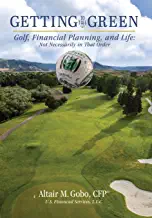Getting to the Green: Golf, Financial Planning, and Life, Not Necessarily in That Order by Altair Gobo
Altair Gobo has a unique way of looking at money, financial planning and wealth: He sees similarities between money management and the game of golf. Taking his experience as an avid golfer for 20 years and his 35 years as a CFP, Altair put this analogy and experience together in his new book, Getting to the Green: Golf, Financial Planning, and Life, Not Necessarily in That Order.
BookTrib recently had a sit down with Gobo to talk about his book and to ask one very critical question: ‘Is it ever too late to plan for the future?’
BookTrib: You’ve taken a really unique approach to explaining financial planning; you liken it to the game of golf. How did you come up with that analogy?
AG: Well, I’ve been doing this [financial planning] for almost 35 years and I’ve been playing golf for almost 20 years. The more I played golf, the more I realized it really is a microcosm of life. As you play and watch other people play, you learn about their game. You observe their temperaments, whether or not they are a good sport, honest; you learn whether or not they have the propensity to take risks. So much of this is connected. In financial planning, these are the things you learn about people in terms of how they handle their money and finances. In financial planning we talk about diversification. The same is true in golf: you are allowed to have 14 different clubs, each one is designed to do something different. No one carries 14 drivers or 14 putters. The same is true with investing: you don’t put all your money into one stock, you diversify your interests. Just as some [golf] clubs are designed to go long distances and some for shorter distances, stocks are the same; there are some you invest in that have a quick return and others that are long-term investments. You don’t put all your money in one or the other, but come up with a combination of diverse investments.
BookTrib: That’s very difficult for most people because they are so worried about losing money, especially when finances are tight. How do you help people overcome that fear?
AG: In golf we have what are called hazards. These are strategically placed areas factored into the design of the golf course. In order to avoid these, you have to look at the game and know where they are and depending on how much risk you want to take, you make decisions as to how you will avoid them or not. As golfers, we realize that we can control some things and then there are some we can’t control or remedy like the weather or the wind. The same is true with financial planning; there are things we can control, what we chose to invest in and then things we can’t; I have no control about what the market will do today, so I focus on the things that I can. This can also be applied to life. In golf, there are the people who really take the game seriously. When you’re serious about it, you start to play and as you improve, you develop a plan for your game: ‘Where do I want to hit?’ You come up with a strategy and then you implement it. If you don’t have a plan how will you know how well you are doing?
BookTrib: Right! Then tell me this: I look at myself and my peers. We are now approaching middle age, going into our 40s. A lot of us avoided the planning for retirement in our 20s and 30s because we thought we were too young. Then here come the 40s sneaking up on us and now retirement is no longer 40 years away, but 20 years away and you realize that 20 years can fly by. Is it too late to start saving and investing more aggressively for retirement or when is too young to start?
AG: You’re never too young to start investing in your future; the sooner you start the more compounding facotors you have in your favor. If someone were to tell you that if you were to put away $2,000 per year for 30 years— at an average rate of 6% interest the stock market, you would have $158,000 saved in 30 years. When I tell people this and they hear it, they say, ‘Wow, I could really have a ton of money saved.’ Now, the question becomes discipline. When I ask, ‘Can you save 10% of what you make?’ Most people hesitate on that. But when you phrase it this way an ask, ‘Can you live on 90% of what you make?’ Then they look at it differently. The discipline part, it’s the pain of discipline versus the pain of regret. Everyone knows how much they are making but very few know how much they are spending. If you make, say $50,000 a year and after all your bills and living expenses are paid and at the end of the year you have nothing saved, then that means you are spending every single penny you make. Then, it becomes a matter of trying to figure out where that is being spent.
BookTrib: That’s true. We do a lot of mindless spending. For example, I’m a mom and sometimes, I am so tired, I don’t feel like making dinner so I stop at a drive-thru, pick dinner up and go home. But unless I stop and write that down, it is an expense, I forget about, that we all forget about and we do it like it’s nothing.
AG: Exactly. Some people go everyday and buy a cup of coffee at Starbucks everyday, but don’t write down those expenses. Think about it. that’s about $6.00 a day. Now, multiply that amount over a year; that’s $2,190 per year— there’s your $2,000 per year you could save right there. You’re right, we do it like it’s nothing and writing these things down is important. The key is to write it down. That’s like when people make New Year’s Resolutions, how many actually keep them?
BookTrib: Probably one percent or less.
AG: Right, or less! That’s because they don’t write them down; they keep in their heads, and don’t tell people who could probably help them and hold them accountable. That’s like me saying I want to lose 20 pounds; that’s my long-term goal. When I say it, it seems like a lot, but then when you break it down, it really is only about a half a pound a week. That’s not a lot and I realize, ‘I can do that.’
BookTrib: So basically, take these long-term goals and break them down into short-term goals. That way they don’t seem so daunting and you can exercise discipline, right?
AG: Yes, take long-term goals and make them short-term goals. Break those down and make them smaller, more manageable. People that you know who might not have a lot of cash on site may have a 401K. In their 401K, they have thousands saved, but because they don’t have immediate access to it and it is taken from their pay before they even see it, they don’t miss it, but the money put into a 401K is being invested in some riskier stocks that may have a quick return, others that grow more slowly; it’s diversified. But because you aren’t doing the investing, you’ve taken the emotion, the administration out of it. People who have a 401K might not have a lot of money outside of that. But that money that’s put aside in the 401K is going into market 520 different times over the course of about 20 years. There, you did all the right things and you never miss that money. You’re being smart with your savings and that’s what it’s all about. Having a good financial planning IQ is like having a good golf IQ: you may hit a ball in middle of woods, but you still try to advance it.
BookTrib: It seems that women are more shy about investing and getting to learn the ins and outs of investing and money management for a number of reasons. For many it is the intimidation that it’s so mathematical and as women we are inclined to believe that we can’t be good at math and accounting or things that are related to it. How do you help women become more comfortable with investing their money?
AG: It used to be that men took the lead on investing because men were the primary breadwinners. But, I’m seeing that change where more and more; (it used to be the man was the boss, woman was secretary) women are CEOs. Many women still leave finances to men, but then something happens like a divorce or they lose a spouse in some way; they, then, find themselves doing it all for the first time.
Learning about money is not rocket science: what comes in what goes out. You have to be organized and set goals. I believe everybody has the same opportunity, not everybody will have the same outcome. It wasn’t as easy as it looked, I said I have to take a lesson. The first guy I took lessons with was like a therapist; he taught me to do the right things. Same is true with financial planning; some do it and are successful, but I always advise, as a professional, get a second opinion. If you, as a woman, are comfortable with a woman find one, just find whoever makes you feel comfortable. In medicine, they have what is called bedside manner; well in financial planning, we have what is called “desk-side manner.” You have to be empathetic and sympathetic to your clients.
BookTrib: I have family members who have significant health issues that will carry on throughout old age. it seems most people don’t really factor these costs into retirement. How do people with these needs save?
AG: Most people focus on investing for retirement; some estate planning, college planning, special needs planning. Financial planning and investing lacks sex appeal so most people don’t go there. Few think about insurance. People hate paying for it. But if they ever need it, they love it. Insurance has so many benefits, we just have to overcome the cost or figure a way for it to become affordable. We know we need to plan for special needs. It is important to create a plan that puts that money away. Clients with special needs children always consider this because they have to plan for what happens when, as parents, they can no longer care for their children because of old age or when they are no longer here. Forget the cost – it is as necessary to plan for special needs as it is to plan for who is is going to do it [care for the special needs children]. Also, that [chronic illness] is a special need that a lot of people don’t plan for. You know, we talk about the stuff we want to talk about, we don’t want to talk about the misgivings, but we have to because it is imperative we build and plan for our financial future; the plan is a solid foundation we all need.
With estate planning, we take our clients through what we call a ‘lifeboat drill.’ Say you died yesterday, we show you what happens to your estate and who ends up in control of your estate when you are gone. Our clients are told they can’t do anything about it because they aren’t here, they just have to watch what unfolds. God forbid something happens to you, but I bet if you took a poll of your friends, most don’t have a will. You have to ask yourself, what do I want to happen? What arrangements have I made with funeral planning, burial, children and custody, taxes. All of that is very important and easier than most people think, but it is like golf, you have to think about the long game.
Buy this Book!
Amazon




